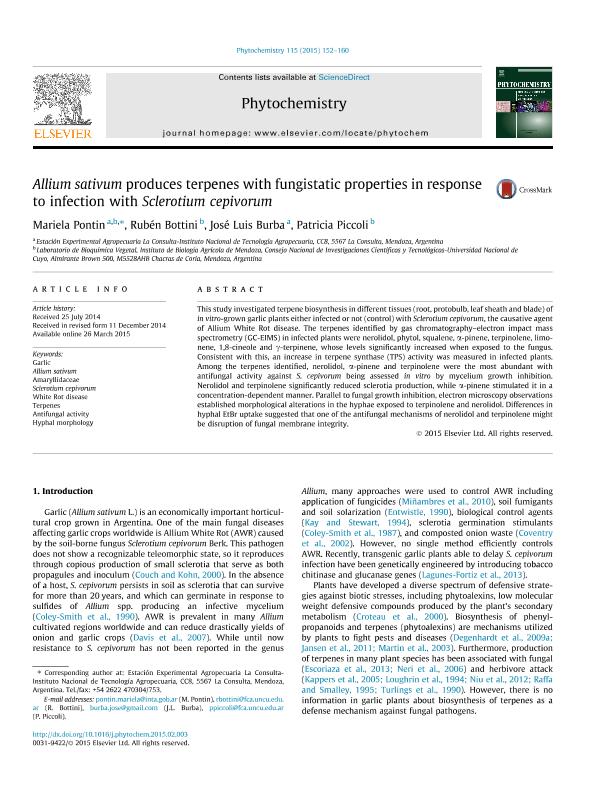Artículo
Allium sativum produces terpenes with fungistatic properties in response to infection with Sclerotium cepivorum
Fecha de publicación:
26/07/2015
Editorial:
Elsevier
Revista:
Phytochemistry
ISSN:
0031-9422
Idioma:
Inglés
Tipo de recurso:
Artículo publicado
Resumen
This study investigated terpene biosynthesis in different tissues (root, protobulb, leaf sheath and blade) of in vitro-grown garlic plants either infected or not (control) with Sclerotium cepivorum, the causative agent of Allium White Rot disease. The terpenes identified by gas chromatography–electron impact mass spectrometry (GC-EIMS) in infected plants were nerolidol, phytol, squalene, a-pinene, terpinolene, limonene, 1,8-cineole and c-terpinene, whose levels significantly increased when exposed to the fungus. Consistent with this, an increase in terpene synthase (TPS) activity was measured in infected plants. Among the terpenes identified, nerolidol, a-pinene and terpinolene were the most abundant with antifungal activity against S. cepivorum being assessed in vitro by mycelium growth inhibition. Nerolidol and terpinolene significantly reduced sclerotia production, while a-pinene stimulated it in a concentration-dependent manner. Parallel to fungal growth inhibition, electron microscopy observations established morphological alterations in the hyphae exposed to terpinolene and nerolidol. Differences in hyphal EtBr uptake suggested that one of the antifungal mechanisms of nerolidol and terpinolene might be disruption of fungal membrane integrity.
Archivos asociados
Licencia
Identificadores
Colecciones
Articulos(CCT - MENDOZA)
Articulos de CTRO.CIENTIFICO TECNOL.CONICET - MENDOZA
Articulos de CTRO.CIENTIFICO TECNOL.CONICET - MENDOZA
Articulos(IBAM)
Articulos de INST.DE BIOLOGIA AGRICOLA DE MENDOZA
Articulos de INST.DE BIOLOGIA AGRICOLA DE MENDOZA
Citación
Pontin, Mariela Ana; Bottini, Ambrosio Rubén; Burba, José Luis; Piccoli, Patricia Noemí; Allium sativum produces terpenes with fungistatic properties in response to infection with Sclerotium cepivorum; Elsevier; Phytochemistry; 115; 26-7-2015; 152-160
Compartir
Altmétricas




